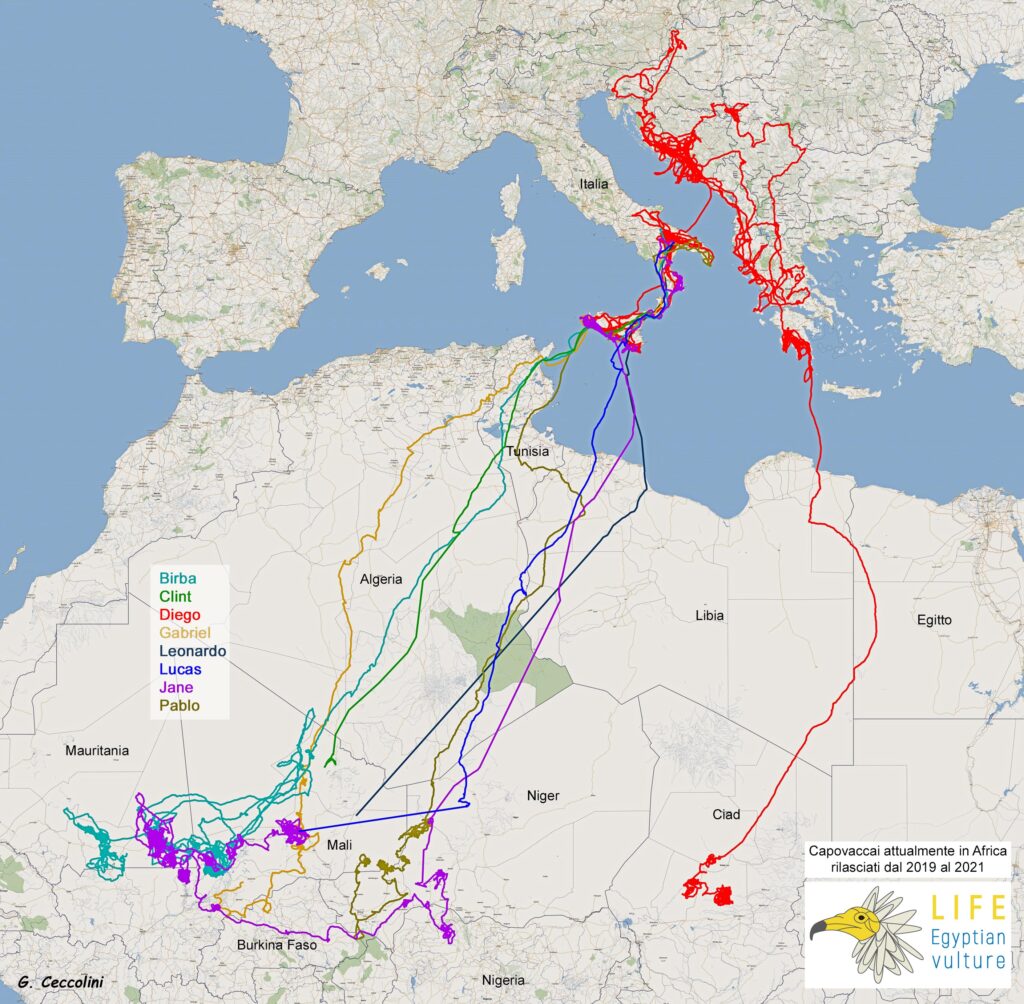We take stock, at the end of 2021, of the outcome of the release operations of young Egyptian vultures carried out within the framework of the LIFE Egyptian vulture project.
In total, between 2018 and 2021, 19 specimens were released in Basilicata, in the Parco della Murgia Materana. All of them were born in captivity at CERM Centro Rapaci Minacciati and of these 11 were released in their year of birth, three at one year of age and five at two years of age.
Eight young people reached African wintering areas. Seven of them did this in the year of release, at the end of the summer (Leonardo, Jane, Birba, Clint, Gabriel, Pablo and Lucas). Only Diego, a vulture released in 2019 at the age of one, behaved differently: after spending the first two winter seasons in Sicily, he undertook the migration to Africa in September 2021 starting from the southern tip of Greece, which he reached after wandering around Eastern Europe for five months.
Diego is also the only one of the eight Egyptian vultures currently wintering in Africa to be in Chad, the usual wintering area of Balkan Egyptian vultures; the other seven young vultures are all in Mali. Mali had already proved to be the preferred wintering ground for Italian Egyptian vultures; in fact, it had been the destination of other captive-born Egyptian vultures released by the CERM Association before the start of the LIFE Egytpian vulture project.
Once in Africa, some of the eight young Egyptian vultures released in Basilicata stayed more or less in the same area, while others made more substantial journeys that took them to various countries in the sub-Saharan strip. Jane, for example, visited Niger, Nigeria, Burkina Faso and Mauritania before reaching Mali, where she is currently located.
What happened to the other 11 individuals released in Basilicata? Two of them were recaptured after release because they were showing difficulties in adapting to wild life and were subsequently returned to CERM.

Five individuals unfortunately died of anthropogenic causes. Clara was shot in Sicily in 2018, Bianca died of probable poisoning in Tunisia in 2018 and Isabel disappeared in Malta in 2021; although her body has not been found, there are indications that she was the victim of poaching. Lucrezia and Juanita, on the other hand, died as a result of electrocution on medium voltage power lines, not far from the release area. Lucrezia, released in 2019, had spent the winter in Calabria and then returned to the release area the following spring.
Two young people, Noah in 2019 and Fabio in 2020, died by drowning in the Mediterranean Sea while migrating to Africa. Unfortunately, this is not an uncommon cause of natural death. It occurs when young people, who have not encountered other ‘experienced’ migrants, take a wrong route across many hundreds of kilometres of open sea. This also happens to wild-born young.
The causes of Kate’s death in Sicily in 2020 during the wintering period and Beatrice’s disappearance in 2019, shortly after her release, remain unknown.
So far, the outcome of the releases is undoubtedly positive, despite the significant impact caused by some anthropogenic threats (electrocution, poaching and poisoning). This is especially true for the individuals that were released in their year of birth, a high percentage of which (over 54%) managed to reach their wintering areas.
The data acquired through the use of GPS, with which the vultures are equipped, make it possible to verify the outcome of releases and, extremely important for the conservation of the species, to identify the main causes of mortality.

